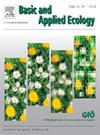Integration of ground-based and remote sensing data with deep learning algorithms for mapping habitats in Natura 2000 protected oak forests
IF 3.5
2区 环境科学与生态学
Q2 ECOLOGY
引用次数: 0
Abstract
Landscape changes caused by climate change require new methods for forest research, analysis, mapping, and monitoring. This study aims to combine ground-based and remote sensing data utilising deep learning techniques to map protected forest habitats and communities within the Natura 2000 network. The study also seeks to evaluate the accuracy of this approach, specifically in oak-dominated forests, as well as identify the optimal time period within a year for effective habitat identification.
Using the specialised software NaturaSat, automated segmentations were performed based on the coordinates of phytosociological relevés and forest strands defined in database. Oak-dominated forest habitats were differentiated solely through multispectral data obtained from Sentinel-2 satellites. A dataset was selected for the training of a deep learning algorithm called the Natural Numerical Network on the basis of the analysis results. This algorithm aims to create a prediction map of habitats dominated by Quercus cerris, which is also known as the relevancy map.
Through the utilisation of the Natural Numerical Network, a training accuracy of 95.24% was achieved. Field validation, which was conducted at randomly generated locations within the relevancy map, yielded an accuracy of 98.33%. The most distinguishing differences in band characteristics between the two oak-dominated habitats were observed during the autumn months.
This study presents a framework that integrates terrestrial and remote sensing data. This method can serve as a basis for mapping forest habitats and observing changes related to climate change. Moreover, it contributes to the documentation of nature conservation and the mapping of landscapes.
基于地面和遥感数据与深度学习算法的整合,用于绘制Natura 2000保护栎林的栖息地
气候变化引起的景观变化需要新的森林研究、分析、制图和监测方法。本研究旨在利用深度学习技术将地面和遥感数据结合起来,在Natura 2000网络中绘制受保护的森林栖息地和社区。该研究还试图评估这种方法的准确性,特别是在橡树为主的森林中,并确定一年内有效识别栖息地的最佳时间段。利用专业软件NaturaSat,根据数据库中定义的植物社会学相关的坐标和森林链进行自动分割。仅通过Sentinel-2卫星获得的多光谱数据来区分橡树为主的森林生境。在分析结果的基础上,选择一个数据集进行深度学习算法“自然数值网络”的训练。该算法的目的是创建一个栎树占主导地位的栖息地预测图,也称为关联图。利用自然数值网络,训练准确率达到95.24%。在关联图中随机生成的位置进行现场验证,准确度为98.33%。两种栎木为主的生境在带带特征上最显著的差异出现在秋季。本研究提出了一个整合地面和遥感数据的框架。该方法可作为绘制森林生境图和观测与气候变化有关的变化的基础。此外,它还有助于记录自然保护和绘制景观图。
本文章由计算机程序翻译,如有差异,请以英文原文为准。
求助全文
约1分钟内获得全文
求助全文
来源期刊

Basic and Applied Ecology
环境科学-生态学
CiteScore
6.90
自引率
5.30%
发文量
103
审稿时长
10.6 weeks
期刊介绍:
Basic and Applied Ecology provides a forum in which significant advances and ideas can be rapidly communicated to a wide audience. Basic and Applied Ecology publishes original contributions, perspectives and reviews from all areas of basic and applied ecology. Ecologists from all countries are invited to publish ecological research of international interest in its pages. There is no bias with regard to taxon or geographical area.
 求助内容:
求助内容: 应助结果提醒方式:
应助结果提醒方式:


